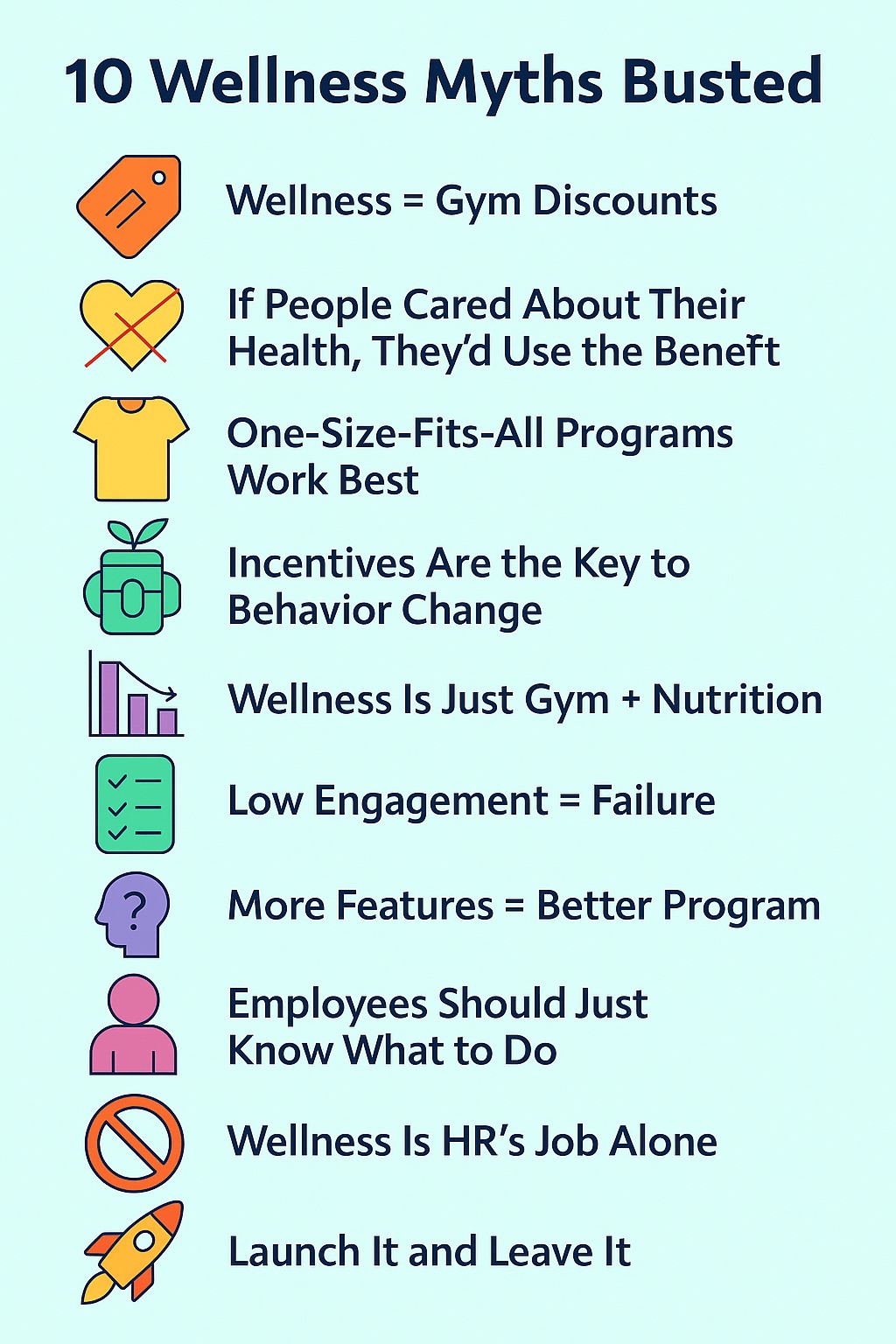Busting Myths and Changing Lives
When was the last time you challenged what you think you know about employee wellness?
Recently, our co-founders sat down for a candid, unscripted conversation about the most common (and persistent) workplace wellness myths they see.
What started as a casual dialogue quickly turned into a rapid-fire myth-busting session — complete with laughs, a few hot takes, and some serious truth-telling.
But if you’re short on time or just want the highlights, we’ve distilled their conversation into a bite-sized list, perfect for a quick break over a hot beverage. It’s straight to the point and packed with real insights every HR leader and business owner should know. Now let’s go!

1. Wellness = Gym Discounts
It’s the classic move: offer employees a gym discount and check the wellness box. But here’s the problem, it rarely works.
As Tim pointed out: “If 30,000 people actually showed up to a Planet Fitness on a Tuesday night, the system would collapse.” These low-cost gym models often rely on people not showing up.
The truth: Discounts don’t drive results. What matters is whether people actually engage and that often requires a deeper investment of time, energy, and relevance.
2. If People Cared About Their Health, They’d Use the Benefit
We love this quote from the conversation:
“You’re probably already spending money on weight-loss things, gadgets, plans… so why aren’t you using your employer benefit?”
Because care doesn’t equal clarity. People may want to get healthier but feel overwhelmed, ashamed, or simply confused by what’s offered.
The truth: A lack of engagement doesn’t mean a lack of desire, it often points to friction in the experience.
3. One-Size-Fits-All Programs Work Best
Cookie-cutter programs might check all the “compliance” boxes, but they rarely change lives. What works for your corporate office may fall flat with your night-shift warehouse crew.
The truth: Personalization is power. The more your programs reflect your employees’ roles, rhythms, and realities, the more impact you’ll see.
4. Incentives Are the Key to Behavior Change
While rewards can kickstart engagement, they don’t lead to long-term transformation.
The truth: True change comes from intrinsic motivation and sustainable habits, not just swag, sweepstakes, or step challenges.
5. Wellness Is Just Gym Plus Nutrition
Far too many programs are built around calories and cardio. But that’s only scratching the surface.
The truth: A modern wellness strategy includes mental health, financial wellbeing, social connection, purpose, and yes, even sleep hygiene.
6. Low Engagement = Failure
If few people sign up, it must not be working… right? Not necessarily.
The truth: Success isn’t always visible. A single therapy session might prevent a burnout spiral. A 2-minute video might help a new parent feel less alone. Not every impact shows up on a dashboard.
7. More Features = Better Program
Clark joked about “stacking features” like that makes the program more appealing. But more isn’t always better.
The truth: People don’t need more, they need simpler. A focused, streamlined experience will always outperform a bloated portal packed with underused tools. Falling for workplace wellness myths only adds to the noise.
8. Employees Should Just Know What to Do
“Wellness” is a deeply personal journey, but most people aren’t experts in behavior change or health psychology.
The truth: They need guidance, not guesswork. Strong programs include coaching, clear nudges, and easy-to-follow action plans.
9. Wellness Is HR’s Job Alone
Sure, HR may spearhead the initiative, but it’s not theirs to own alone.
The truth: When operations leaders, exec sponsors, line managers, and peers buy in, wellness becomes a company-wide culture not just a compliance task.
10. Launch It and Leave It
You stood up a program, sent the email, and… nothing. That’s because wellness isn’t “set it and forget it.”
The truth: Wellness programs need nurturing. That means ongoing comms, feedback loops, iterations, and leadership visibility.

Final Thoughts
Beneath all these myths is one powerful truth: Workplace wellness isn’t a perk, it’s a performance strategy.
The best companies know this. They don’t treat wellness as a checkbox, but as a core pillar of retention, culture, and long-term growth.
If you recognized even one of these myths in your own organization, you’re not alone. But you are in a powerful position to change the narrative.
Ready to audit your wellness strategy? Let’s talk.
Author

Avidon Health is transforming how organizations promote healthier lifestyles through behavior change science and technology-driven coaching. Our mission is to empower individuals to achieve better health outcomes while driving measurable business success for our clients.
With over 20 years of expertise in health coaching and cognitive behavioral training, we’ve built a platform that delivers personalized, 1-to-1 well-being experiences at scale.
Today, organizations use Avidon to reimagine engagement, enhance health, and create lasting behavior change—making wellness more accessible, impactful, and results-driven.
